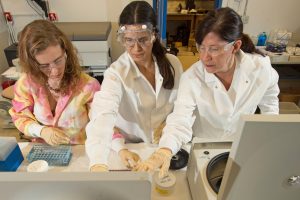Study Compares Natural Sunlight Effects on Macondo and Surrogate Oil
– JULY 27, 2016
Scientists developed the first molecular-level comparison of photochemical effects on surrogate and Macondo (MC252) oil to better understand this weathering process and the toxicity mechanisms it produces.
The team observed increased nitrogen in surrogate oil’s response to sunlight and oxidation across a wider range of carbon numbers than MC252. Solar exposure inhibited microbial production in both oils, suggesting that sunlight contributes to bacterial toxicity. They published their findings in the Marine Pollution Bulletin: Photochemical changes in water accommodated fractions of MC252 and surrogate oil created during solar exposure as determined by FT-ICR MS.
Many researchers studying the effects of the Deepwater Horizon spill use surrogate oil in experiments because of limited availability of MC252. Even with similar geochemical properties, there are slight compositional differences in oils that can influence their response to photochemical degradation. Recent advances in analytical techniques now allow scientists to see more clearly the structural transformations in petroleum residues.
This study’s team exposed surrogate and MC252 oil to natural sunlight as water-soluble oil fractions formed (known as Water Accommodated Fractions or WAFs) in sterile seawater. Using Fourier Transform Ion Cyclotron Resonance Mass Spectrometry (FT-ICR MS), they measured WAFs in oil incubated in unfiltered full sunlight, sunlight with ultraviolet radiation blocked, and darkness.
“This study focuses on several critical issues related to oil spill research and provides insight into the effects of photo-toxicity,” said study authors Pamela Vaughan and Wade Jeffrey. They explained that their results raise the issue of a standard method for creating WAFs which is typically done under dark conditions, “Our data indicate that WAFs created under more natural conditions have a very different biological effect.” They continued, “Perhaps more importantly it highlights the effects of light exposure and resulting bacterial toxicity. Sunlight greatly increases the toxicity of oil to marine bacteria, but those photochemical changes in toxicity are driven by visible light, not the suspected ultraviolet radiation.”
The study’s authors are Pamela P. Vaughan, Tashiema Wilson, Rebecca Kamerman, Melissa E. Hagy, Amy McKenna, Huan Chen, and Wade H. Jeffrey.
This paper’s data are publicly available through the Gulf of Mexico Research Initiative Information & Data Cooperative (GRIIDC) at https://data.gulfresearchinitiative.org/data/R4.x267.181:0007/.
Read about advances to improve laboratory quality assurance/quality control practices for inter-laboratory comparison and petroleum compound calibration in the Hydrocarbon Intercalibration Experiment Report (located here and here).
************
This research was made possible in part by grants from the Gulf of Mexico Research Initiative (GoMRI) to the Deepsea to Coast Connectivity in the Eastern Gulf of Mexico (Deep-C) consortium and to the Center for integrated Modeling and Analysis of Gulf Ecosystems (C-IMAGE). Other funding sources include the National Science Foundation Division of Materials Research (11-54790) State of Florida grant.
The GoMRI is a 10-year independent research program established to study the effect, and the potential associated impact, of hydrocarbon releases on the environment and public health, as well as to develop improved spill mitigation, oil detection, characterization and remediation technologies. An independent and academic 20-member Research Board makes the funding and research direction decisions to ensure the intellectual quality, effectiveness and academic independence of the GoMRI research. All research data, findings and publications will be made publicly available. The program was established through a $500 million financial commitment from BP. For more information, visit https://gulfresearchinitiative.org/.
© Copyright 2010- 2017 Gulf of Mexico Research Initiative (GoMRI) – All Rights Reserved. Redistribution is encouraged with acknowledgement to the Gulf of Mexico Research Initiative (GoMRI). Please credit images and/or videos as done in each article. Questions? Contact web-content editor Nilde “Maggie” Dannreuther, Northern Gulf Institute, Mississippi State University (maggied@ngi.msstate.edu).






